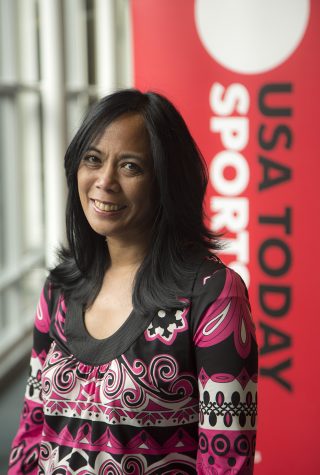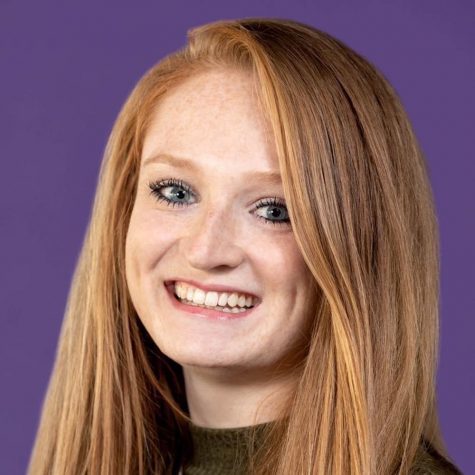Women in sports media: making waves in a field dominated by men
Women in sports media share stories about their experiences in a traditionally male-dominated field.
Hawkeye sports were hot in the 1990s. Dan Gable and the Iowa wrestling team won seven NCAA titles, and C. Vivian Stringer coached the 1992-93 Iowa women’s basketball team to the most dominant finish in program history — the Final Four of the NCAA Tournament.
As a University of Iowa student and The Daily Iowan sports reporter, Roxanna Scott was right in the middle of it.
Scott, now the sports managing editor for USA Today, followed Stringer and the Iowa women’s basketball team to Atlanta, where the Final Four was held. For Scott, it was her first experience with national news.
“At that time, when I started off that season, I did not think that was where we’d end up,” Scott said. “I just remember seeing the coverage on a national level of a team that I had been following all season — it was just surreal to me … I think it just gave me an idea of how to cover a large event, and what the national media was like.”
And in the 90s, Scott was lucky enough to have women to look up to in the DI sports section. She worked among the likes of Melissa Isaacson — who covered the Chicago Bulls in its 1990s reign over the NBA for the Chicago Tribune — and Kris Wiley, Scott’s former sports editor.

“[Wiley], of course, was a female sports editor, and someone I very much looked up to,” Scott said. “… I think it’s not just having sports colleagues to look up to who are female, and who can be your allies and supporters, but also having the leaders in the newsroom.”
The number of women sports media professionals continues to be far below that of men, and many women are subject to spurs of doubt and harassment by their male counterparts. But those women who have been successful in the industry say the challenges were worth it and serve as role models for those coming behind them.
“I’ve been very lucky to work with editors that made diversity in the newsroom a priority,” Scott said. “Working at the Dallas Morning News, and then USA Today, I’ve always felt like our leadership has been very supportive of having diverse voices and editors who tell all the stories, so they reflect our audience and the people we are writing about.”
But not all women working in sports media have been as lucky as Scott. UI graduate Kimberly Bates grew up loving sports, and knew she wanted to work in sports, specifically with Major League Baseball.
The summer before her final year at Iowa, Bates took an internship with a collegiate summer baseball team as its on-field host. She was one of two female interns in a room full of male interns. The first day she was with the team, the general manager pulled her and the other female intern aside to talk about something he found important to only them.
“I was accused of only getting the internship because I wanted to sleep with the baseball players,” Bates said. “That was the first thing that the GM had to tell me and the only other girl intern — that there’s no flirting, talking to, or sleeping with the baseball players.”
Closer to home, women sports journalists at the DI also recognized some of their experiences are not the same as their male peers.
According to a recent survey done by the DI, 72 percent of staffers in the DI newsroom are women. In the sports section, there are two reporters that identify as women out of 10 sports reporters in the print sports section. Women are more represented in DITV sports, as over half of DITV sports staffers — five out of nine — are women.

Anna Kayser worked for the DI starting in fall 2017 as a sports reporter. Eventually, she became the sports editor and edited the DI’s weekly Friday football special edition for the fall 2019 semester before graduation.
“You kind of have to find your own way,” Kayser said. “Being with the sports section, you have to deal with things that the guys don’t have to deal with a lot of the time.”
Kayser noted a specific instance in her first year covering Iowa wrestling — star Iowa wrestler Spencer Lee was sidelined with kidney stones, and nobody knew if he was going to be able to wrestle in the upcoming meet. After Lee made it into the probable lineup for the meet, she wrote a brief at the direction of her editors, but was scrutinized by a male journalist at a wrestling press conference.
“He basically just called me out for writing that brief,” Kayser said. “And was like ‘You have no idea what you’re talking about or what’s important because you’re a woman.’”
According to a 2018 report of about 75 different sports-media companies done by the Institute for Diversity and Ethics in Sport, only 10 percent of sports reporters at the time were women. The report also included the fifth consecutive ‘F’ for gender hiring practices in sports media, as the percentage of women sports reporters has stayed the same since 2012.
Leah Vann was named the new Cedar Rapids Gazette Iowa football beat reporter in January, making her the first woman in more than 20 years to be on the sports desk of the Gazette and the only woman on the Hawkeye football beat in the state. Vann graduated from the Medill School of Journalism at Northwestern with a master’s degree in journalism in June 2020.
“I knew the next step in my career was to be a college football beat writer,” Vann said. “And I don’t know if I’m going to stay in college football … but with two years of professional experience and a graduate degree, I knew it was what I was qualified to do.”
Vann received her undergraduate degree in biology at the University of Texas at Austin — her home state — but realized halfway through her college career that she wanted to be a sports writer instead of a doctor. After battling cancer as a child, she felt pulled to the medical world, although it was not truly something she wanted to do.

“I was going to go to medical school,” Vann said. “I went through a lot of medical stuff as a kid, I’m a cancer survivor of almost 10 years this June, so when you go through something like that you feel the pressure to do something in the health care field.
“But my heart and soul has always been in sports,” she said.
So, she started working at The Daily Texan her junior year of college and found a job in sports writing with the Globe Gazette in Mason City, Iowa, after she graduated. She then moved on to be the sports editor of the Steamboat Pilot & Today in Colorado, before attending Northwestern and getting the job she has today with the Gazette.
Vann’s hiring was a long time coming. In Scott’s almost three decades of experience as a woman of color in sports media, she’s noticed how the industry has shifted.
“Now, I think it’s not at all unusual to see women in the press box or in the locker room interviewing players after games,” Scott said. “Just because there are more women who have seen Lesley Visser on the sideline of an NFL game, or have seen Sage Steele on ESPN … It’s no longer unusual to have women. We are a part of this group, and we have shown that we belong.”
Although more women are making their way into the sports media field, the fear of being harassed on social media doesn’t stop. According to a 2014 report by the International Women’s Media Foundation, nearly one-third of female journalists consider leaving the profession because of online attacks and threats.
“I have never once felt threatened by any athlete that I’ve had to work with,” Kayser said. “But it never really leaves the back of your mind that if an athlete or a coach or somebody has your phone number, that could happen.”
While Vann was a prep sports reporter in Colorado, she was harassed and stalked by a parent of a high school athlete she was covering.
“I think he found me attractive,” Vann said. “Which is disturbing, since his son is closer in age to me than I am to him. So, he did call my office, and tell me that I had a ‘rockin’ body’ and that he would like to take me fishing.”
As more and more women slowly trickle into the sports-media industry, it’ll become easier for women to finally be widely accepted by athletes, fans, and other media organizations as professional journalists.
But for now, Kayser stresses leaning on coworkers that support women unequivocally.
“I met some of my best friends at the DI, when I started with the sports section,” Kayser said. “I found that those guys always had my back, on everything that happened.”



